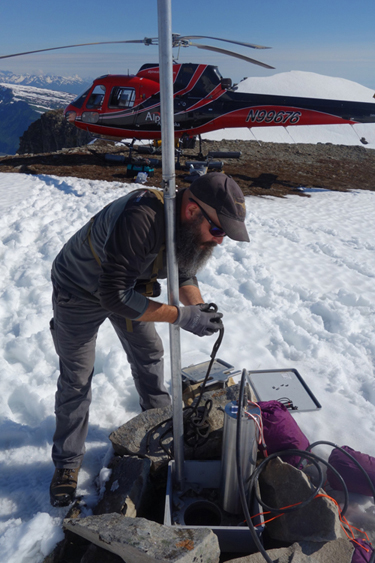30 June 2020–Adding relatively inexpensive magnetometers to seismic stations across Alaska could help track geomagnetic storms as well as improve the performance of the seismometers, researchers report in the Bulletin of the Seismological Society of America. The paper is one of several included in an upcoming SRL focus section about EarthScope in Alaska and Canada.
As solar winds—plasma ejected from the Sun—interact with the Earth’s magnetic field at the poles, they create fluctuations in the magnetic field. These space weather “storms” can affect electrical grids and GPS systems, among other impacts.
Researchers have long known that seismometers are highly sensitive to all sorts of other environmental phenomena beyond seismic waves, including changes in temperature, air pressure and magnetic fields. For the most part, these are “unwanted signals” that seismologists seek to remove from their data, said Adam Ringler of the U.S. Geological Survey’s Albuquerque Seismological Laboratory.

In the Alaska portion of the Incorporated Research Institutions for Seismology (IRIS) Transportable Array, a network of temporary seismometers that has been placed across the U.S., the unwanted magnetic signal is particularly noticeable. “I was blown away by how well you can record magnetic storms across the array,” Ringler said.
The storm signals are distinct in part because the seismic stations are located at high latitudes, where geomagnetic activity is higher. In addition, the temporary stations are not shielded from magnetic fields in the same way as many permanent seismic stations. In permanent stations, the seismometers are often cloaked in mu-metal, a nickel-iron alloy that directs magnetic fields around the shielded sensors.
In their BSSA paper, Ringler and colleagues demonstrate how placing a magnetometer near a seismic station can help seismologists detect these storm signals and remove them from the seismic data collected by the station. The cost of installing a magnetometer is about $700, while a mu-metal casing costs about $2000, Ringler noted.
At the same time, geomagnetism researchers could significantly expand their own data collection if magnetometers were paired with the hundreds of seismic stations in Alaska’s Transportable Array.
The instruments would not be calibrated at a level that could help scientists measure long-term geomagnetic trends called secular variation, like the “wandering” of the Earth’s poles, said Ringler. However, they could help researchers learn more about the location and movement of shorter-lived geomagnetic storms.
It’s still unclear exactly how the magnetic flux signal is captured by a seismometer’s sensors, Ringler said. Most of the sensors in the Alaskan Transportable Array are in steel tubes about six feet under the ground, so the magnetic flux line may be trapped in the tube, or conducted through the ground. “We can quantify it but we don’t actually know the physical principles behind it,” he said.
The idea of using seismic stations as a multi-purpose hub for collecting geosciences data isn’t new, but their collaborative potential is growing, said Ringler, noting that the Alaska array already has associated weather stations. “Seismology has a lot of infrastructure,” he said, “and there’s now a possibility for things like geomagnetism groups to piggyback off this infrastructure, so they can record the things they’re interested in.”
